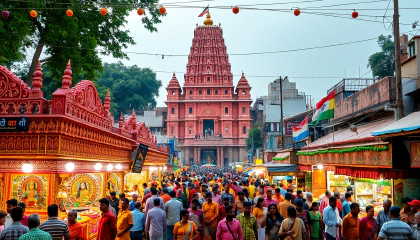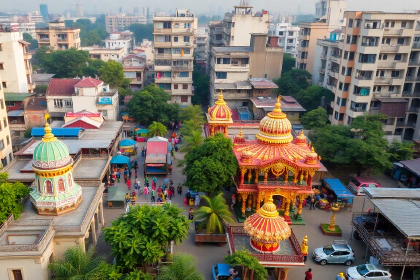
Ward 190's Green Revolution: Roadmap to Urban Sustainability
Empowering Urban Sustainability in Ward 190: A Roadmap for Eco-Friendly Development
Introduction
Ward 190, encompassing the vibrant communities of Chittaranjan Park, Kalkaji DDA Flats, and Alaknanda, stands at a crucial juncture in its urban development journey. As Delhi grapples with the challenges of rapid urbanization, this ward presents a unique opportunity to implement sustainable practices that can transform it into a model of eco-friendly urban living. This article explores comprehensive strategies for enhancing sustainability in Ward 190, focusing on effective waste and stormwater management, energy-efficient building practices, and community engagement initiatives. By leveraging its rich cultural heritage and strong community bonds, Ward 190 can pave the way for a greener, more resilient urban future.
Revolutionizing Waste and Stormwater Management
Implementing Advanced Waste Segregation Systems
Ward 190’s journey towards sustainability begins at the grassroots level with a revolutionary approach to waste management. By implementing an advanced waste segregation system, the ward can significantly reduce its environmental footprint. This system involves:
- Providing color-coded bins for different types of waste (organic, recyclable, and non-recyclable) in residential areas and public spaces
- Establishing community composting centers for organic waste, creating valuable fertilizer for local parks and gardens
- Collaborating with local recycling facilities to ensure proper processing of recyclable materials
Innovative Stormwater Management Solutions
To address issues of flooding and waterlogging, Ward 190 can adopt cutting-edge stormwater management techniques:
- Installing bioswales along major roads and in parks to naturally filter and redirect stormwater
- Creating rainwater harvesting systems in public buildings and encouraging their adoption in private residences
- Developing “sponge parks” that can absorb excess rainwater, doubling as recreational spaces during dry seasons
These initiatives not only mitigate flood risks but also contribute to groundwater recharge, addressing Delhi’s chronic water scarcity issues.
Embracing Energy-Efficient Building Practices
Promoting Green Building Standards
Ward 190 can lead the way in sustainable construction by adopting and enforcing green building standards:
- Mandating LEED or GRIHA certification for all new constructions above a certain size
- Offering incentives for existing buildings to retrofit with energy-efficient systems
- Promoting the use of locally sourced, sustainable building materials to reduce carbon footprint
Harnessing Renewable Energy
The ward can significantly reduce its reliance on fossil fuels by:
- Installing solar panels on government buildings, schools, and community centers
- Creating a community solar program allowing residents to invest in shared solar projects
- Implementing smart grid technologies to optimize energy distribution and consumption
Fostering Community Engagement for Sustainable Living
Launching Environmental Education Programs
Empowering residents with knowledge is crucial for long-term sustainability:
- Organizing workshops on waste segregation, composting, and energy conservation
- Collaborating with local schools to integrate environmental education into curricula
- Hosting regular eco-fairs to showcase sustainable technologies and practices
Creating Community-Driven Green Spaces
Transforming underutilized areas into vibrant green spaces can enhance community engagement:
- Developing the proposed Eco-Theme Park at Jahanpanah Park as a model of sustainable urban design
- Encouraging community gardens in residential blocks, promoting local food production
- Redesigning existing parks with native plants, water-efficient landscaping, and community gathering areas
Case Study: Chittaranjan Park’s Transformation
Chittaranjan Park, with its unique Bengali heritage, offers a compelling case study for sustainable urban renewal. By leveraging its strong community bonds and cultural institutions, C.R. Park has implemented several successful initiatives:
- The Chittaranjan Park Bangiya Samaj has spearheaded a community-wide waste segregation program, achieving 80% compliance within a year.
- Market Number 1 has been transformed into a model of sustainable commerce, featuring solar-powered stalls and a zero-waste policy.
- The Deshbandhu Chittaranjan Memorial Society has converted its grounds into a demonstration site for rainwater harvesting and native plant cultivation.
These initiatives not only improve environmental outcomes but also strengthen the community’s cultural identity and social cohesion.
Conclusion
Ward 190 stands at the threshold of a sustainable urban revolution. By implementing comprehensive strategies for waste and stormwater management, embracing energy-efficient building practices, and fostering community engagement, this ward can become a beacon of eco-friendly development in Delhi. The success of initiatives in Chittaranjan Park demonstrates the power of combining cultural heritage with environmental stewardship. As Ward 190 moves forward with its sustainability roadmap, it not only enhances the quality of life for its residents but also sets a precedent for urban renewal across India. The journey towards a greener, more resilient Ward 190 is not just about environmental conservation; it’s about creating a vibrant, livable community that future generations will be proud to call home.





